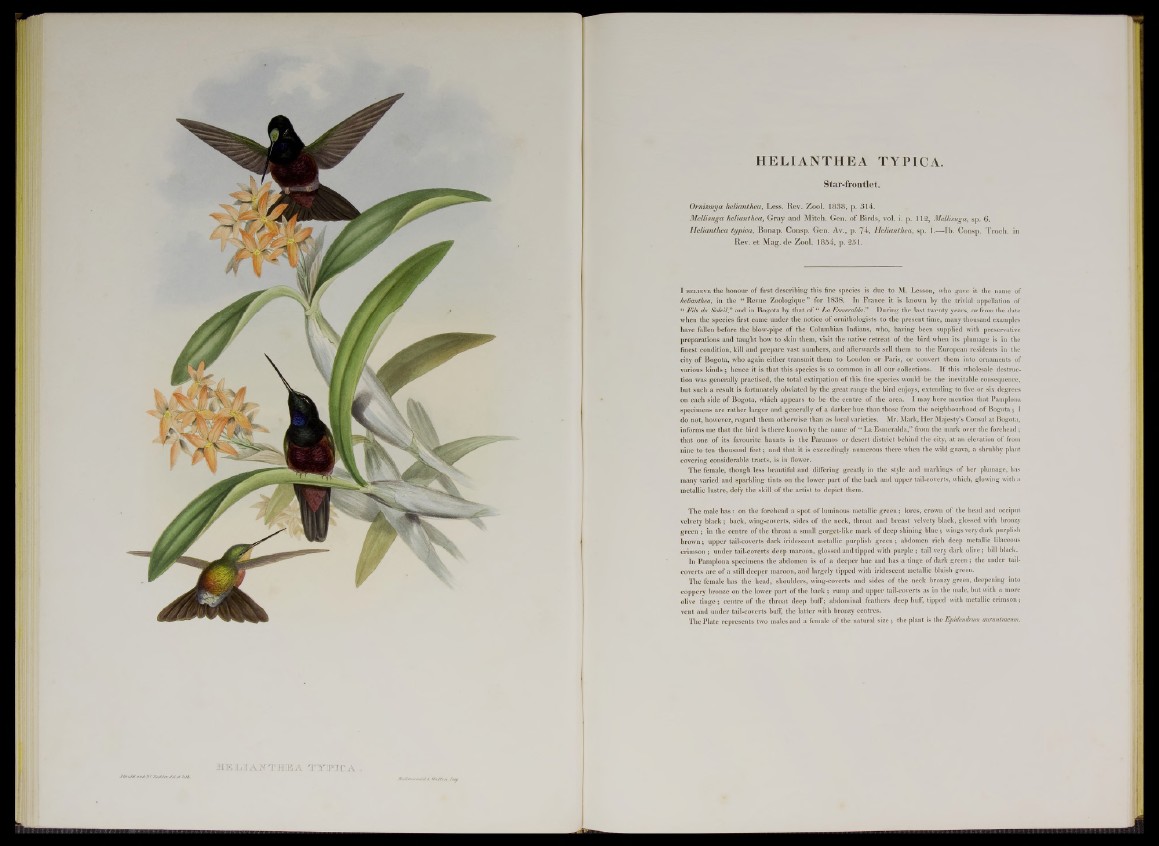
HE L IANTHEA TYPICA.
Star-frontlet.
Ornismya helianthea, Less. Rev. Zool. 1838, p. 314.
Mellisuga heliantheu, Gray and Mitch. Gen. o f Birds, vol. i. p. 112, Mellisuga, sp. 6.
Helianthea typica, Bonap. Consp. Gen. Av., p. 74, Helianthea, sp. 1.— lb . Consp. Troch. in
Rev. e t Mag. de Zool. 1854, p. 251.
I b e l i e v e the honour of first describing this fine species is due to M. Lesson, who gave it the name of
helianthea, in the “ Revue Zoologique” for 1838. In France it is known by the trivial appellation of
“ Fils du Soleil,” and in Bogota by that of “ La Esmeralda.” During the last twenty years, or from the date
when the species first came under the notice of ornithologists to the present time, many thousand examples
have fallen before the blow-pipe of the Columbian Indians, who, having been supplied with preservative
preparations and taught how to skin them, visit the native retreat of the bird when its plumage is in the
finest condition, kill and prepare vast numbers, and afterwards sell them to the European residents in the
city of Bogota, who again either transmit them to London or Paris, or convert them into ornaments of
various kinds ; hence it is that this species is so common in all our collections. If this wholesale destruction
was generally practised, the total extirpation of this fine species would be the inevitable consequence,
but such a result is fortunately obviated by the great range the bird enjoys, extending to five or six degrees
on each side of Bogota, which appears to be the centre of the area. I may here mention that Pamplona
specimens are rather larger and generally of a darker hue than those from the neighbourhood of Bogota ; I
do not, however, regard them otherwise than as local varieties. Mr. Mark, Her Majesty’s Consul at Bogota,
informs me that the bird is there known by the name of “ La Esmeralda,” from the mark over the forehead;
that one of its favourite haunts is the Paramos or desert district behind the city, at an elevation of from
nine to ten thousand feet; and that it is exceedingly numerous there when the wild guava, a shrubby plant
covering considerable tracts, is in flower.
The female, though less beautiful and differing greatly in the style and markings of her plumage, has
many varied and sparkling tints on the lower part of the back and upper tail-coverts, which, glowing with a
metallic lustre, defy the skill of the artist to depict them.
The male has: on the forehead a spot of luminous metallic green; lores, crown of the head and occiput
velvety black; back, wing-coverts, sides of the neck, throat and breast velvety black, glossed with bronzy
green ; in the centre of the throat a small gorget-like mark of deep shining blue; wings very dark purplish
brown; upper tail-coverts dark iridescent metallic purplish green ; abdomen rich deep metallic lilaceous
crimson ; under tail-coverts deep maroon, glossed and tipped with purple ; tail very dark olive; bill black.
In Pamplona specimens the abdomen is of a deeper hue and has a tinge of dark green; the under tail-
coverts are of a still deeper maroon, and largely tipped with iridescent metallic bluish green.
The female has the head, shoulders, wing-coverts and sides of the neck bronzy green, deepening into
coppery bronze on the lower part of the back ; rump and upper tail-coverts as in the male, but with a more
olive tinge; centre of the throat deep buff; abdominal feathers deep buff, tipped with metallic crimson;
vent and under tail-coverts buff, the latter with bronzy centres.
The Plate represents two males and a female of the natural size ; the plant is the Epidendrum auranttacum.